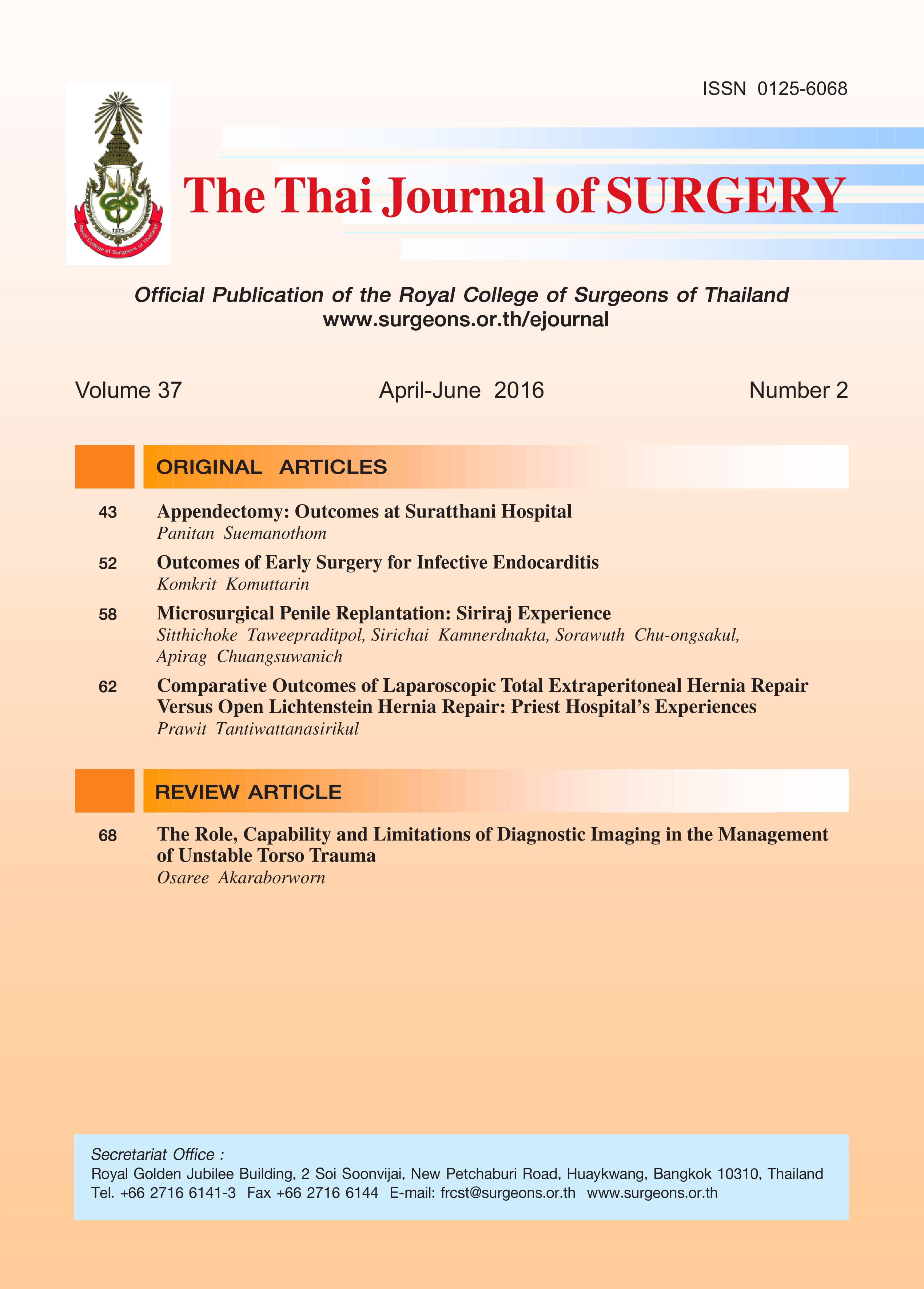Comparative Outcomes of Laparoscopic Total Extraperitoneal Hernia Repair Versus Open Lichtenstein Hernia Repair: Priest Hospital’s Experiences
Keywords:
Inguinal hernia, laparoscopic total extraperitoneal hernia repair, LichtensteinAbstract
Background: Laparoscopic repair of inguinal hernia is increasingly performed. Many studies demonstrated that laparoscopic repair had benefits of less postoperative pain, faster recovery and no difference in complications and recurrence rate. Priest Hospital, with its unique patients’ characteristics and hospital policy, has never studied the outcomes of this surgery.
Objective: To compare laparoscopic total extraperitoneal hernia repair (TEP) with Lichtenstein hernia repair (LT).
Patients and Methods: From June 2012 - June 2015, 275 patients underwent elective inguinal hernia repair at Priest Hospital. A retrospective review of demographic data, operative outcomes and complications were analyzed.
Results: There were 116 patients in LT group and 117 patients in TEP group (42 patients were excluded from the study). This study demonstrated significantly less postoperative pain score in TEP group at 4 hrs. (p < 0.001) and 24 hrs. (p = 0.043) after surgery but not significantly different at 48 hrs. (p = 0.094). The patients in LT group significantly needed more intravenous opioid drugs (p <0.001). The operative time was longer in TEP (p < 0.001) while the length of stay was shorter in TEP (p <0.001). For postoperative pain at 1 week and 1 month of follow up, there were more patients with pain in LT group (p < 0.001 and p = 0.017, respectively) but not significantly different in terms of chronic pain (p = 0.983), numbness (p = 0.079) and recurrence rate (p =0.369). Overall complications were not different (p = 0.296).
Conclusion: TEP had advantage of less postoperative pain, faster recovery, shorter hospital stay but had longer operative time. It can be done safely with no difference in complication and recurrence rate.
References
2. Lomanto D, Cheah WK, Faylona JM, et al. Inguinal hernia repair: toward asian guideline. Asian J Endosc Surg 2015; 8:16-23.
3. McCormack K, Scott NW, Go PM, Ross SJ, Grant A, EU Hernia Trialists Collaboration. Laparoscopic techniques versus open techniques for inguinal hernia repair. Cochrane Database Syst Rev 2008;1:CD001785.
4. Awad SS, Fagan SP. Current approaches to inguinal hernia repair. Am J Surg 2004;188:9S-16S.
5. Pavlidis TE, current opinion on laparoscopic repair of inguinal hernia. Surg Endosc 2010;24:974-76.
6. Scott NW, McCormack K, Graham P, Go PM, Ross SJ, Grant AM. Open mesh versus non-mesh for repair of femoral and inguinal hernia. Cochrane Database Syst Rev 2002;4: CD002197.
7. EU Hernia Trialists Collaboration Mesh compared with nonmesh methods of open groin hernia repair: systematic review of randomized controlled trials. Br J Surg 2000;87: 854-859.
8. Fitzgibbons RJ, Forse RA. Groin hernia in adults. N Engl J Med 2015;372:756-63.
9. Simons MP, Aufenacker T, Bay-Nielsen M, et al. European hernia society guidelines on the treatment of inguinal hernia in adult patients. Hernia 2009;13:343-403.
10. Grant A. Laparoscopic compared with open methods of groin hernia repair: systematic review of randomized controlled trials. Br J Surg 2000;87:860-7.
11. Memon MA, Cooper NJ, Memon B, Memon MI, Abrams KR. Meta-analysis of randomized clinical trials comparing open and laparoscopic inguinal hernia repair. Br J Surg 2003; 90:1479-92.
12. Lichtenstein IL, Shulman AG, Amid PK, Montllor MM. The tension-free hernioplasty. Am J Surg 1989;157:188-193.
13. Wake BL, McCormack K, Fraser C, Vale L, Perez J, Grant A. Transabdominal pre-peritoneal (TAPP) vs totally extraperitoneal (TEP) laparoscopic techniques for inguinal hernia repair. Cochrane Database Syst Rev 2005;1:CD004703.
14. Bansal VK, Misra MC, Babu D, et al. A prospective, randomized comparison of long-term outcomes: chronic groin pain and quality of life following totally extraperitoneal (TEP) and transabdominal preperitoneal (TAPP) laparoscopic inguinal hernia repair. Surg Endosc 2013;27:2373-82.
15. Bittner R, Arregui ME, Bisgaard T, et al. Guidelines for laparoscopic (TAPP) and endoscopic (TEP) treatment of inguinal hernia (International Endohernia Society: IEHS). Surg Endosc 2011;25:2773-843.
16. Bittner R, Montgomery MA, Arregui E, et al. Update of guidelines on laparoscopic (TAPP) and endoscopic (TEP) treatment of inguinal hernia (International Endohernia Society). Surg Endosc 2015;29:289-321.
17. Miserez M, Peeters E, Aufenacker T, et al. Update with level 1 studies of the European hernia society guidelines on the treatment of inguinal hernia in adult patients. Hernia 2014; 18:151-63.
18. Puri V, Felix E, Fitzgibbons RJ. Laparoscopic vs conventional tension free inguinal herniorrhaphy: 2005 Society of American Gastrointestinal Endoscopic Surgeons (SAGES) annual meeting debate. Surg Endosc 2006;20:1809-16.
19. Singh AN, Bansal VK, Misra MC, et al. Testicular functions, chronic groin pain, and quality of life after laparoscopic and open mesh repair of inguinal hernia: a prospective randomized controlled trial. Surg Endosc 2012;26:1304-17.
20. Eklund A, Montgomery A, Bergkvist L, Rudberg C. Chronic pain 5 years after randomized comparison of laparoscopic and Lichtenstein inguinal hernia repair. Br J Surg 2010;97:600-8.
Downloads
Published
How to Cite
Issue
Section
License
Articles must be contributed solely to The Thai Journal of Surgery and when published become the property of the Royal College of Surgeons of Thailand. The Royal College of Surgeons of Thailand reserves copyright on all published materials and such materials may not be reproduced in any form without the written permission.



